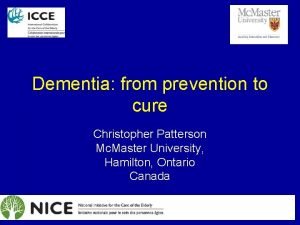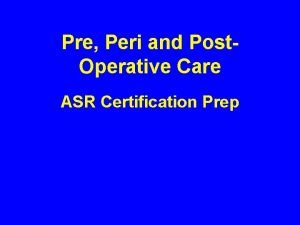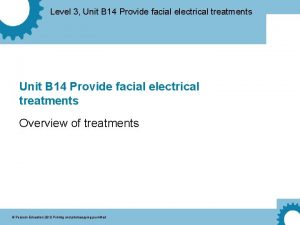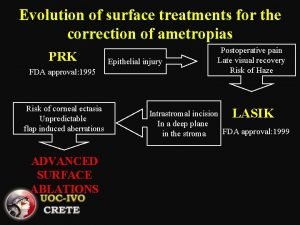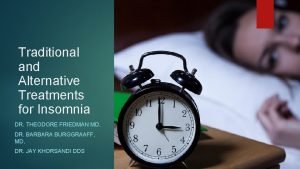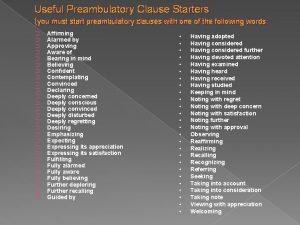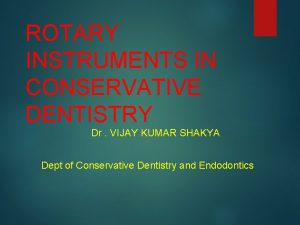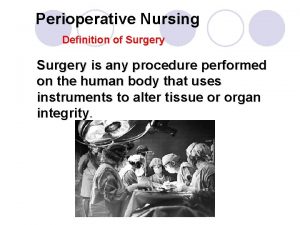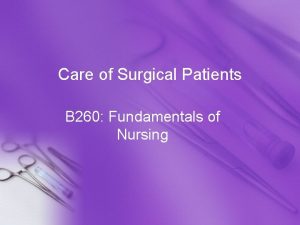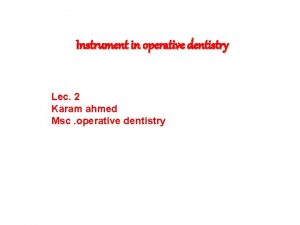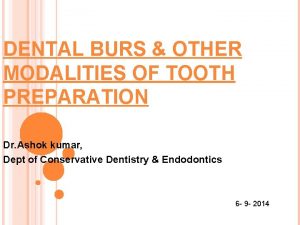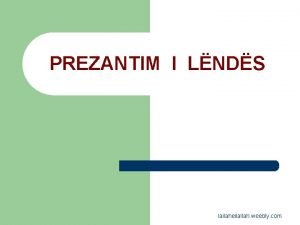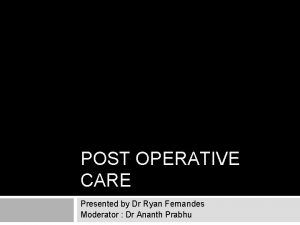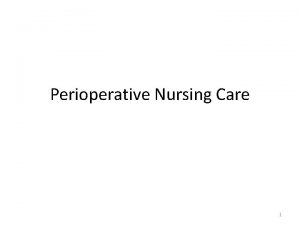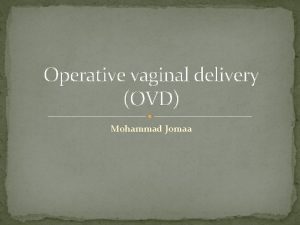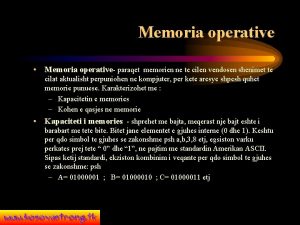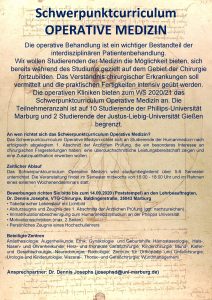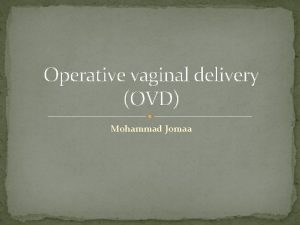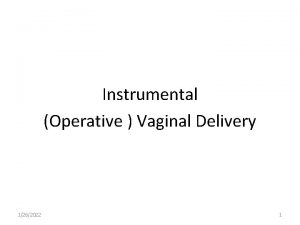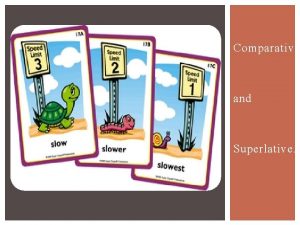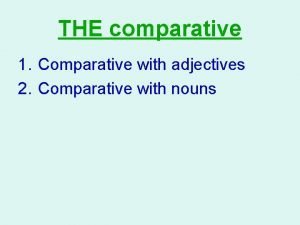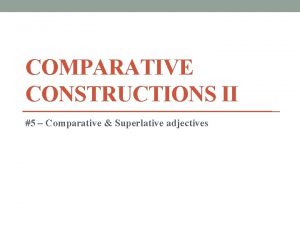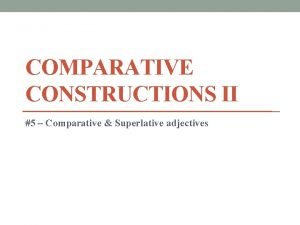Comparative Effectiveness of Nonoperative and Operative Treatments for






































- Slides: 38

Comparative Effectiveness of Nonoperative and Operative Treatments for Rotator Cuff Tears Prepared for: Agency for Healthcare Research and Quality (AHRQ) www. ahrq. gov

Overview (1) Background: Numerous approaches exist for managing rotator cuff (RC) tears. Purpose: To compare the benefits and harms of nonoperative and operative interventions on clinically important outcomes in adults with rotator cuff tears. Seida JC, et al. Ann Intern Med 2010; 153: 246 -55; Seida J, et al. AHRQ Comparative Effectiveness Review No. 22. Available at: http: //effectivehealthcare. ahrq. gov/index. cfm/search-for-guides-reviews-and-reports/? pageaction=displayproduct&product. ID=467.

Overview (2) Data Sources: Twelve electronic databases (1990 to September 2009), grey literature, trial registries, and reference lists were searched. Study Selection: Controlled and uncontrolled studies in various languages were considered. Data Extraction: Two reviewers assessed risk for bias, and one reviewer rated the evidence by using a modified GRADE approach. Seida JC, et al. Ann Intern Med 2010; 153: 246 -55; Seida J, et al. AHRQ Comparative Effectiveness Review No. 22. Available at: http: //effectivehealthcare. ahrq. gov/index. cfm/search-for-guides-reviews-and-reports/? pageaction=displayproduct&product. ID=467.

Overview (3) Data synthesis: 137 studies met eligibility criteria. All trials had high risk for bias. Cohort and uncontrolled studies were of moderate quality. Limitations: Low-quality, limited evidence precluded conclusions for most comparisons. Language restrictions may have excluded some relevant studies. Selective outcome reporting may have introduced bias. Seida JC, et al. Ann Intern Med 2010; 153: 246 -55; Seida J, et al. AHRQ Comparative Effectiveness Review No. 22. Available at: http: //effectivehealthcare. ahrq. gov/index. cfm/search-for-guides-reviews-and-reports/? pageaction=displayproduct&product. ID=467.

Overview: Conclusions Evidence is too limited to provide support for earlier surgical intervention when compared to the current practice of nonoperative interventions followed by surgery if needed. Significant improvements were seen after both operative and nonoperative interventions. There is limited evidence for benefits and harms to guide choice among various operative approaches, and insufficient evidence to choose among nonoperative approaches. Future studies are required. Seida JC, et al. Ann Intern Med 2010; 153: 246 -55; Seida J, et al. AHRQ Comparative Effectiveness Review No. 22. Available at: http: //effectivehealthcare. ahrq. gov/index. cfm/search-for-guides-reviews-and-reports/? pageaction=displayproduct&product. ID=467.

Outline of the Study Introduction The comparative effectiveness review (CER) process Comparative effectiveness for patient-related outcomes from: Early vs. late operative intervention Nonoperative vs. operative interventions Nonoperative interventions Operative interventions Postoperative rehabilitation Comparative harms Prognostic factors Future research needs AHRQ. Methods Reference Guide for Effectiveness and Comparative Effectiveness Reviews, Version 1. 0. Available at: http: //effectivehealthcare. ahrq. gov/rep. Files/2007_10 Draft. Methods. Guide. pdf; Seida J, et al. AHRQ Comparative Effectiveness Review No. 22. Available at: http: //effectivehealthcare. ahrq. gov/index. cfm/search-for-guides-reviews-and-reports/? pageaction=displayproduct&product. ID=467.

Incidence of Rotator Cuff Tears Rotator cuff (RC) tears can occur because of traumatic injury or degeneration. Incidence of RC tears is related to increasing age. Fifty-four percent of patients >60 years of age have a partial or complete RC tear when compared with 4 percent of adults <40 years of age. RC tears may be asymptomatic or cause significant pain, weakness, and limitation of motion. Seida J, et al. AHRQ Comparative Effectiveness Review No. 22. Available at: http: //effectivehealthcare. ahrq. gov/index. cfm/search-for-guides-reviews-and-reports/? pageaction=displayproduct&product. ID=467.

Managing Rotator Cuff Tears Both nonoperative and operative treatments are used to relieve pain and restore shoulder movement and function. Patients usually first undergo 6 to 12 weeks of nonoperative treatment, which may consist of any combination of: Pain management (medications and injections) Rest from activity Passive and active exercise Treatments with heat, cold, or ultrasound Seida J, et al. AHRQ Comparative Effectiveness Review No. 22. Available at: http: //effectivehealthcare. ahrq. gov/index. cfm/search-for-guides-reviews-and-reports/? pageaction=displayproduct&product. ID=467.

Managing Rotator Cuff Tears (2) The rotator cuff may be surgically repaired by using an open, mini-open, or all-arthroscopic approach when nonoperative therapy fails or for certain patients with traumatic tears. Following operative interventions, various postoperative rehabilitation programs are used to restore range of motion, muscle strength, and function. Patients and clinicians face several decisional dilemmas, including whether to opt for early surgical intervention or if and when to forgo nonoperative treatment for operative intervention. Seida J, et al. AHRQ Comparative Effectiveness Review No. 22. Available at: http: //effectivehealthcare. ahrq. gov/index. cfm/search-for-guides-reviews-and-reports/? pageaction=displayproduct&product. ID=467.

The CER Development Process (1) The publicly nominated topic was reviewed and selected based on need, importance, and feasibility. Experts and stakeholders guided development of the clinical questions that were made available for public comment. A specialized Technical Expert Panel assisted the research process and development of the draft report. AHRQ. Methods Reference Guide for Effectiveness and Comparative Effectiveness Reviews, Version 1. 0. Available at: http: //effectivehealthcare. ahrq. gov/rep. Files/2007_10 Draft. Methods. Guide. pdf; Seida J, et al. AHRQ Comparative Effectiveness Review No. 22. Available at: http: //effectivehealthcare. ahrq. gov/index. cfm/search-for-guides-reviews-and-reports/? pageaction=displayproduct&product. ID=467.

The CER Development Process (2) Methods for literature review, data collection, and metaanalysis followed version 1. 0 of the Methods Reference Guide for Effectiveness and Comparative Effectiveness Reviews. The draft CER was subject to public comment and peer review. The complete final report is available online. AHRQ. Methods Reference Guide for Effectiveness and Comparative Effectiveness Reviews, Version 1. 0. Available at: http: //effectivehealthcare. ahrq. gov/rep. Files/2007_10 Draft. Methods. Guide. pdf; Seida JC, et al. Ann Intern Med 2010; 153: 246 -55; Seida J, et al. AHRQ Comparative Effectiveness Review No. 22. Available at: http: //effectivehealthcare. ahrq. gov/index. cfm/search-for-guides-reviews-and-reports/? pageaction=displayproduct&product. ID=467.

Clinical Questions Addressed by the CER Comparative effectiveness of outcomes from: Early vs. late operative intervention Nonoperative vs. operative interventions Nonoperative interventions Operative interventions Postoperative rehabilitation Comparative harms from operative and nonoperative interventions Prognostic factors Seida J, et al. AHRQ Comparative Effectiveness Review No. 22. Available at: http: //effectivehealthcare. ahrq. gov/index. cfm/search-for-guides-reviews-and-reports/? pageaction=displayproduct&product. ID=467.

Clinical Outcomes of Interest Health-related quality of life Shoulder function Time to return to work/activities Cuff integrity Pain Range of motion Strength of the shoulder Seida J, et al. AHRQ Comparative Effectiveness Review No. 22. Available at: http: //effectivehealthcare. ahrq. gov/index. cfm/search-for-guides-reviews-and-reports/? pageaction=displayproduct&product. ID=467.

Four Domains Used To Assess Relevant Studies Risk of bias Consistency Directness Precision Atkins D, et al. BMJ 2004; 328: 1490; Seida J, et al. AHRQ Comparative Effectiveness Review No. 22. Available at: http: //effectivehealthcare. ahrq. gov/index. cfm/search-for-guides-reviews-and-reports/? pageaction=displayproduct&product. ID=467.

Rating the Strength of Evidence From the CER The strength of evidence was classified into four broad categories: High Further research is very unlikely to change the confidence in the estimate of effect. Moderate Further research may change the confidence in the estimate of effect and may change the estimate. Low Further research is likely to change the confidence in the estimate of effect and is likely to change the estimate. Insufficient Evidence either is unavailable or does not permit estimation of an effect. Atkins D, et al. BMJ 2004; 328: 1490; Seida J, et al. AHRQ Comparative Effectiveness Review No. 22. Available at: http: //effectivehealthcare. ahrq. gov/index. cfm/search-for-guides-reviews-and-reports/? pageaction=displayproduct&product. ID=467.

Early vs. Late Operative Intervention for Rotator Cuff Tears

Early vs. Late Surgical Intervention for Rotator Cuff Tears Only one study compared immediate surgical repair with late surgical repair after failed nonoperative treatment. Randomized. Moderate sample size (n=103). Significance not reported. Trend for greater improvement with immediate surgery. Evidence is too limited to draw conclusions about the comparative effectiveness of early surgical repair when compared to late surgical repair following nonoperative interventions. Low level of evidence. Moosmayer S, et al. J Bone Joint Surg Br 2010; 92: 83 -91; Seida J, et al. AHRQ Comparative Effectiveness Review No. 22. Available at: http: //effectivehealthcare. ahrq. gov/index. cfm/search-for-guides-reviews-and-reports/? pageaction=displayproduct&product. ID=467.

Comparative Effectiveness of Nonoperative vs. Operative Interventions for Rotator Cuff Tears • Five comparative studies (2 randomized controlled trials and 3 cohort studies)

Comparisons Studied for Nonoperative vs. Operative Interventions Shock-wave therapy vs. mini-open rotator cuff repair (RCR). Steroid injection, physical therapy, and activity modification vs. open RCR. Physical therapy (manual therapy and strengthening and stability exercises) vs. open or mini-open RCR. Physical therapy, oral medication, and steroid injection vs. open RCR vs. arthroscopic debridement. Steroid injection, stretching, and strengthening vs. open RCR. Seida J, et al. AHRQ Comparative Effectiveness Review No. 22. Available at: http: //effectivehealthcare. ahrq. gov/index. cfm/search-for-guides-reviews-and-reports/? pageaction=displayproduct&product. ID=467.

Results for Comparative Effectiveness of Nonoperative vs. Operative Interventions Significant improvements were seen in all study groups, regardless of the intervention. Although there was a trend for better outcomes with surgery, results were too limited to permit definitive conclusions. Low level of evidence. Seida J, et al. AHRQ Comparative Effectiveness Review No. 22. Available at: http: //effectivehealthcare. ahrq. gov/index. cfm/search-for-guides-reviews-and-reports/? pageaction=displayproduct&product. ID=467.

Comparative Effectiveness of Nonoperative Interventions for Rotator Cuff Tears • Three comparative studies (1 randomized controlled trial, 2 retrospective cohort studies).

Comparative Effectiveness of Nonoperative Interventions for Rotator Cuff Tears: Overview Nonoperative intervention comparisons studied: Sodium hyaluronate vs. dexamethasone Rehabilitation vs. no rehabilitation Physical therapy and oral medications with or without steroid injections Because of the variety of interventions and the low quality of studies, no conclusions could be drawn about the most effective nonoperative patient-management strategy. Seida J, et al. AHRQ Comparative Effectiveness Review No. 22. Available at: http: //effectivehealthcare. ahrq. gov/index. cfm/search-for-guides-reviews-and-reports/? pageaction=displayproduct&product. ID=467.

Comparative Effectiveness of Operative Repair for Rotator Cuff Tears • Thirty-two controlled studies (5 randomized controlled trials, 4 controlled clinical trials, 6 prospective cohort studies, 17 retrospective cohort studies). • Thirteen operative comparisons.

Comparative Effectiveness of Operative Repair for Rotator Cuff Tears Functional outcomes with a few exceptions were similar for: Open vs. mini-open repair Mini-open vs. arthroscopic repair Open or mini-open vs. arthroscopic repair Arthroscopic repair with or without acromioplasty Moderate level of evidence Seida J, et al. AHRQ Comparative Effectiveness Review No. 22. Available at: http: //effectivehealthcare. ahrq. gov/index. cfm/search-for-guides-reviews-and-reports/? pageaction=displayproduct&product. ID=467.

Comparative Effectiveness of Operative Repair for Rotator Cuff Tears (2) Outcomes differed in these comparisons: Mini-open vs. open repair Patients may return to work or sports approximately 1 month earlier if they have a mini-open repair (p < 0. 00001). Open repair vs. open or arthroscopic debridement Open repair results in greater improvement in functional outcomes than arthroscopic debridement (p ≤ 0. 03). Moderate level of evidence Seida J, et al. AHRQ Comparative Effectiveness Review No. 22. Available at: http: //effectivehealthcare. ahrq. gov/index. cfm/search-for-guides-reviews-and-reports/? pageaction=displayproduct&product. ID=467.

Comparative Effectiveness of Operative Techniques for Rotator Cuff Tears • Fifteen comparative studies (6 randomized controlled trials, 1 controlled clinical trial, 8 cohort studies) • Modest methodological quality

Comparative Effectiveness of Operative Techniques for Rotator Cuff Tears Comparative differences for postoperative function and cuff integrity are not clinically significant for single-row vs. double-row suture anchor fixation. No difference in cuff integrity between mattress locking and simple stitch was documented. Moderate level of evidence. Seida J, et al. AHRQ Comparative Effectiveness Review No. 22. Available at: http: //effectivehealthcare. ahrq. gov/index. cfm/search-for-guides-reviews-and-reports/? pageaction=displayproduct&product. ID=467.

Comparative Effectiveness of Postoperative Rehabilitation for Rotator Cuff Tears • Eleven studies (10 comparative, 1 uncontrolled). • Most frequently studied comparison was continuous passive motion with physical therapy vs. physical therapy alone (3 studies).

Postoperative Rehabilitation Options for Rotator Cuff Tears Physical therapy with or without continuous passive motion Land-based therapy with or without aquatic therapy Inpatient vs. day-patient rehabilitation Home exercise program with or without individualized physical therapy programs Early progressive activation and then resistive exercises vs. early immobilization followed by delayed progressive resistive exercise Standardized vs. nonstandardized physical therapy programs Videotape vs. physical therapy home-exercise instruction No studies to compare rehabilitation to no rehabilitation, but postoperative rehabilitation has become the standard of care. Seida J, et al. AHRQ Comparative Effectiveness Review No. 22. Available at: http: //effectivehealthcare. ahrq. gov/index. cfm/search-for-guides-reviews-and-reports/? pageaction=displayproduct&product. ID=467.

Comparative Effectiveness of Postoperative Rehabilitation for Rotator Cuff Tears No clinically important or statistically significant difference in function was found, but there was some evidence for earlier return to work with continuous passive motion vs. physical therapy done in postoperative patients. Overall, there was not enough quality evidence to determine the optimal postoperative rehabilitation protocol. Seida J, et al. AHRQ Comparative Effectiveness Review No. 22. Available at: http: //effectivehealthcare. ahrq. gov/index. cfm/search-for-guides-reviews-and-reports/? pageaction=displayproduct&product. ID=467.

Additional Issues Augmentation: Three small comparative studies assessed augmentation, such as grafts or patches, in the rotator cuff tear repair. Evidence was too limited to permit conclusions. Prognostic Factors: Older age, increasing tear size, and extent of preoperative symptoms were associated with recurrent tears in several studies, but evidence was too limited to permit conclusions regarding the relationship of patient or disease characteristics to prognosis. Seida J, et al. AHRQ Comparative Effectiveness Review No. 22. Available at: http: //effectivehealthcare. ahrq. gov/index. cfm/search-for-guides-reviews-and-reports/? pageaction=displayproduct&product. ID=467.

Complication Rates for Rotator Cuff Tear Interventions Overall, complication rates of nonoperative, and postoperative rehabilitation interventions were low. Postoperative complication rates (number of patients with complications during study period): Retears (recurrent tears) ≤ 10% Infection ≤ 5% Stiffness ≤ 8% Reflex sympathetic dystrophy ≤ 2% Neurological injury ≤ 6% Seida J, et al. AHRQ Comparative Effectiveness Review No. 22. Available at: http: //effectivehealthcare. ahrq. gov/index. cfm/search-for-guides-reviews-and-reports/? pageaction=displayproduct&product. ID=467.

Summary of Conclusions Timing of Operative Intervention: Evidence was too limited to permit conclusions about the comparative effectiveness of early surgical repair when compared to late surgical repair following nonoperative interventions. Operative vs. Nonoperative Interventions: Although there was a trend for better outcomes with surgery, results were too limited to permit conclusions. Nonoperative Interventions: The variety of interventions and the low quality of studies precludes any conclusions about the most effective nonoperative patientmanagement strategy. Seida J, et al. AHRQ Comparative Effectiveness Review No. 22. Available at: http: //effectivehealthcare. ahrq. gov/index. cfm/search-for-guides-reviews-and-reports/? pageaction=displayproduct&product. ID=467.

Summary of Conclusions (2) Functional outcomes were similar for open vs. mini-open repair; mini-open vs. arthroscopic repair; open or miniopen vs. arthroscopic repair; and arthroscopic repair with or without acromioplasty. However, exceptions were: Mini-open vs. open repair: Patients may return to work or sports approximately 1 month earlier if they have a mini-open repair (p < 0. 00001). Open repair vs. open or arthroscopic debridement: Open repair results in greater improvement in functional outcomes than does open or arthroscopic debridement (p ≤ 0. 03). Moderate level of evidence. Seida J, et al. AHRQ Comparative Effectiveness Review No. 22. Available at: http: //effectivehealthcare. ahrq. gov/index. cfm/search-for-guides-reviews-and-reports/? pageaction=displayproduct&product. ID=467.

Summary of Conclusions (3) Postoperative Rehabilitation Overall, patients improved over the course of postoperative followup. However, there was not enough quality evidence to determine the optimal postoperative rehabilitation protocol. Adverse Events In general, complication rates were low. The most commonly reported postoperative complications were infection and retears. Seida J, et al. AHRQ Comparative Effectiveness Review No. 22. Available at: http: //effectivehealthcare. ahrq. gov/index. cfm/search-for-guides-reviews-and-reports/? pageaction=displayproduct&product. ID=467.

What To Discuss With Your Patients Whether or not the symptoms of their rotator cuff (RC) tear can be addressed by nonoperative or operative interventions or both, and their values and preferences regarding these options. The patient’s role in adhering to a therapeutic plan whether it is nonoperative or operative, as well as in postoperative rehabilitation. The types of surgery available if surgery is needed. How postoperative rehabilitation will affect their overall clinical outcomes. How long it may take before they will be able to return to their normal daily activities, depending on the required intervention. Any other medical conditions or concerns they may have that will influence the decision to address the RC tear with nonoperative or operative interventions or both.

Gaps in Present Knowledge Additional comparative effectiveness research of open, miniopen, and arthroscopic approaches is a priority, as arthroscopic procedures are more costly and technically more difficult. Studies are needed on the effectiveness of early vs. delayed surgery and nonoperative vs. operative interventions. Also needed are appropriate comparisons of nonoperative treatments, the use of augmentation, analyses of the longterm effectiveness of treatments (minimum of 12 months), and the influence of patient prognostic factors. Seida J, et al. AHRQ Comparative Effectiveness Review No. 22. Available at: http: //effectivehealthcare. ahrq. gov/index. cfm/search-for-guides-reviews-and-reports/? pageaction=displayproduct&product. ID=467.

Future Research Needs Consensus is needed on outcomes that are important to both clinicians and patients to ensure consistency and comparability across future studies. Future studies should be randomized, employ a comparison or control group where appropriate and feasible, and ensure comparability of treatment groups. Seida J, et al. AHRQ Comparative Effectiveness Review No. 22. Available at: http: //effectivehealthcare. ahrq. gov/index. cfm/search-for-guides-reviews-and-reports/? pageaction=displayproduct&product. ID=467.
 Dementia treatments and interventions near patterson
Dementia treatments and interventions near patterson Translation text types
Translation text types S shaped matrix
S shaped matrix Reiss text types
Reiss text types Co operative relationship between investor and entrepreneur
Co operative relationship between investor and entrepreneur Nursing diagnosis cataract nursing care plan
Nursing diagnosis cataract nursing care plan Pre post peri
Pre post peri Cesarean section ppt
Cesarean section ppt Hernia nursing care plan
Hernia nursing care plan Treatments for acute renal failure
Treatments for acute renal failure Level 3 electrical facial
Level 3 electrical facial Alternating treatment design
Alternating treatment design Hiv treatments
Hiv treatments Diabetes treatments
Diabetes treatments Advanced surface treatments
Advanced surface treatments Insomnia treatment
Insomnia treatment Preambulatory clause words
Preambulatory clause words Define smear layer
Define smear layer Instruments
Instruments Operative clauses
Operative clauses Perioperative nurse definition
Perioperative nurse definition Fluothane
Fluothane Preambs
Preambs Post operative nursing care
Post operative nursing care Preambulatory clauses examples
Preambulatory clauses examples Human resource management process
Human resource management process Hrm vs hrd
Hrm vs hrd Operative functions of hrm
Operative functions of hrm Comfed bihar
Comfed bihar Post operative nursing care
Post operative nursing care Sap project system overview
Sap project system overview Operative clauses examples
Operative clauses examples Objectives of operative dentistry
Objectives of operative dentistry Pen grasp in dentistry
Pen grasp in dentistry Tooth preparation bur
Tooth preparation bur Leva operative
Leva operative Dr ryan fernandes
Dr ryan fernandes Perioperative vs preoperative
Perioperative vs preoperative Preoperative patient education ppt
Preoperative patient education ppt
